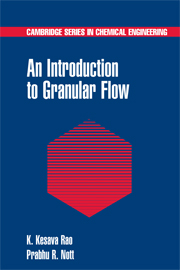Book contents
- Frontmatter
- Contents
- Preface
- Notation
- 1 Introduction
- 2 Theory for Slow Plane Flow
- 3 Flow through Hoppers
- 4 Flow through Wedge-Shaped Bunkers
- 5 Theory for Slow Three-Dimensional Flow
- 6 Flow through Axisymmetric Hoppers and Bunkers
- 7 Theory for Rapid Flow of Smooth, Inelastic Particles
- 8 Analysis of Rapid Flow in Simple Geometries
- 9 Theory for Rapid Flow of Rough, Inelastic Particles
- 10 Hybrid Theories
- Appendix A Operations with Vectors and Tensors
- Appendix B The Stress Tensor
- Appendix C Hyperbolic Partial Differential Equations of First Order
- Appendix D Jump Balances
- Appendix E Discontinuous Solutions of Hyperbolic Equations
- Appendix F Proof of the Coaxiality Condition
- Appendix G Material Frame Indifference
- Appendix H The Evaluation of Some Integrals
- Appendix I A Brief Introduction to Linear Stability Theory
- Appendix J Pseudo Scalars, Vectors, and Tensors
- Appendix K Answers to Selected Problems
- References
- Index
7 - Theory for Rapid Flow of Smooth, Inelastic Particles
Published online by Cambridge University Press: 19 November 2009
- Frontmatter
- Contents
- Preface
- Notation
- 1 Introduction
- 2 Theory for Slow Plane Flow
- 3 Flow through Hoppers
- 4 Flow through Wedge-Shaped Bunkers
- 5 Theory for Slow Three-Dimensional Flow
- 6 Flow through Axisymmetric Hoppers and Bunkers
- 7 Theory for Rapid Flow of Smooth, Inelastic Particles
- 8 Analysis of Rapid Flow in Simple Geometries
- 9 Theory for Rapid Flow of Rough, Inelastic Particles
- 10 Hybrid Theories
- Appendix A Operations with Vectors and Tensors
- Appendix B The Stress Tensor
- Appendix C Hyperbolic Partial Differential Equations of First Order
- Appendix D Jump Balances
- Appendix E Discontinuous Solutions of Hyperbolic Equations
- Appendix F Proof of the Coaxiality Condition
- Appendix G Material Frame Indifference
- Appendix H The Evaluation of Some Integrals
- Appendix I A Brief Introduction to Linear Stability Theory
- Appendix J Pseudo Scalars, Vectors, and Tensors
- Appendix K Answers to Selected Problems
- References
- Index
Summary
PRELIMINARIES AND SCALING
A characteristic feature of slow, quasi-static flow of granular materials, considered in the previous chapters, is the rate independence of the stress. As discussed earlier, in the slow flow regime, grains are in abiding contact and friction is the dominant mechanism for generating shear forces. In this chapter we consider the contrasting regime of rapid flow, in which grains are in continuous fluctuational motion, and come into contact only during very brief collisions.We shall see that the stress in this regime of flow is rate dependent; indeed, the stress varies as the square of the shear rate for shear flow with a spatially uniform shear rate.
Our physical picture of rapid flow is that of grains in a state of constant agitation, with interactions between them occurring only through instantaneous collisions, as shown in Fig. 7.1. To simplify our analysis, we shall assume uniformity in size and shape, and consider the granular material to be composed of smooth spheres. By this, we mean that there is no tangential force exerted by one sphere on the other at the point of contact. This picture is identical to that of molecules in a gas, which is why granular materials in this state are often referred to as “granular gases” in the literature. However, there is a fundamental and crucial difference between a granular material and a gas: collisions or interactions between molecules are elastic, i.e., the net energy of a colliding pair is conserved, but collisions between grains are inelastic.
- Type
- Chapter
- Information
- An Introduction to Granular Flow , pp. 285 - 330Publisher: Cambridge University PressPrint publication year: 2008

